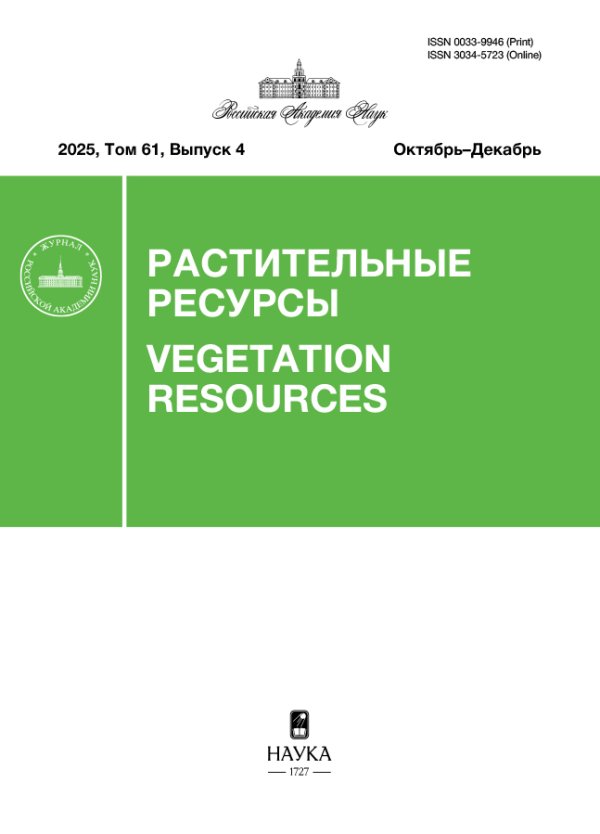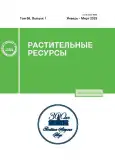Vol 59, No 1 (2023)
REVIEWS
The Genus Iris (Iridaceae) in Russia: Phytochemistry, Biological Activity and Application in Traditional Medicine
Abstract
The genus Iris in Russia is represented by 41 species, of which 4 species are endemic, 11 are included in the Red Book of the Russian Federation and 30 have various regional conservation status. The review provides information on the phytochemical compounds, biological activity and medicinal properties of 16 species growing in Russia, and on their use in traditional medicine of different peoples. The analysis of available data shows that studying the component composition, biological activity levels, and medicinal use of Iris L. species requires their correct identification and the knowledge concerning their geographical distribution, ecology, and morphological characteristics. The use of Iris species in traditional medicine is described. The extracts and compounds isolated from the most of the studied species exhibit analgesic, antioxidative, antipyretic, anti-inflammatory, antibacterial and antimicrobial activity. Some species also have cytotoxic, antitumor, antidiabetic, anti-influenza, neuroprotective, antihyperglycemic, antiallergic, antifeedant and other properties. Most of the isolated metabolites were flavonoids, isoflavonoids, anthocyanes, terpenoids, xantgones, quinones, phenolic and fatty acids. In official and traditional medicine in Asia and Europe, the underground and aboveground parts of Iris aphylla, I. lactea, I. pseudacorus, I. ruthenica, I. sanguinea and other species of the genus are used. The article results from the long-term studies of irises in situ and in the collections of two botanical gardens, as well as extensive examination of literature on the component composition and medicinal properties of the studied species.
 3-29
3-29


Component Composition of Resource Species
Chemical Composition of Glycine soja (Fabaceae) Seeds from the Amur Region Territory
Abstract
Abstract—
Wild soybean Glycine soja Sieb. & Zucc., the wild ancestor of the cultivated soybean Glycine max (L.) Merr., is the source of many valuable genes missing in the genotype of cultivated soybean, including stress resistance to adverse environmental factors. The biochemical parameters (protein, oil, ascorbic acid, carotene, higher fatty acids, specific activity and multiple forms of enzymes of the oxidoreductase and hydrolase classes) of five forms of wild soybeans from the collection of the All-Russian Research Institute of Soybean, which are unique natural gene banks, were studied. The wild seeds were collected for in three districts of the Amur Region (Arkharinsky, Blagoveshchensk, Belogorsky) and grown on the crop rotation field. The obtained results of enzymatic activity (superoxide dismutase, catalase, peroxidase, polyphenol oxidase, ribonuclease, acid phosphatase, esterase and amylase) and biochemical parameters of the studied seeds of wild soybean forms allowed us to identify the form KA-1413 with high biochemical parameters (protein, oleic and linolenic acids), a low specific polyphenol oxidase activity, and an increased activity of superoxide dismutases, esterases and ribonucleases. Thus, the wild soybean form KA-1413 can be recommended as a source of dominant genes, which will help to increase the adaptive potential of new soybean varieties. The increased heterogeneity of multiple forms of SOD, AML, RNase and esterase in wild soybean seeds can be used as adaptation markers to environmental conditions.
 38-53
38-53


Elemental Composition of Reindeer Pasture Plants and Lichens in Nadym District (Yamal-Nenets Autonomous Area)
Abstract
Abstract—
There are plans to expand reindeer husbandry in the Nadym District of the Yamal-Nenets Autonomous Area. For this purpose, we studied the elemental composition of the dominant species of the tundra and open boreal woodland vegetation cover. We analyzed leaves of dwarf birch (Betula nana L.), dwarf shrubs of bog blueberry (Vaccinium uliginosum L.), marsh Labrador tea (Ledum palustre L.), and leatherleaf (Chamaedaphne calyculata (L.) Moench); sphagnum moss (Sphagnum sp. L.); and fruticose lichens (Cladina stellaris (Opiz.) Brodo). The X-ray fluorescence analysis was used to obtain data on the content of Ca, K, P, Si, Mg, Na, S, Zn, Cu, Ni, Co, Fe, Mn, Cr, Ti, and Al. We defined the biogeochemical features of the reindeer forage plants. In vascular plants and sphagnum mosses, the content of almost all essential macroelements is low, while the content of most microelements (Cu, Ni, Co, Cr, and Mn) exceeds the world average values. The lichens are characterized by low concentration of Ca, K, Mg, and P, which is more than one order of magnitude lower than the world average values, and the deficiency of microelements. The results were compared with the results from similar studies in other geographical regions of the tundra zone, and it was found that tundra plants have a similar pattern of element accumulation. In particular, leaves of dwarf birch are distinguished by accumulation of Mg; the content of Al, Fe, and Si is increased in mosses; Mn is accumulated in dwarf shrubs and dwarf birch; lichens are characterized by the deficiency of most elements. Therefore, in order to prevent animal diseases, it is necessary to improve the elemental composition of reindeers feed by increasing the share of “green” forage in winter, when lichens dominate the diet.
 54-64
54-64


The Content of Ash Elements in the Above-Ground Organs of Some Crataegus (Rosaceae) Species
Abstract
Abstract
—The study assessed the content of ash elements in the dry matter of fruits, flowers and leaves of 19 hawthorn (Crataegus L.) species. The plants from the collection of the Botanical Garden-Institute of the Volga State University of Technology (VSUT), the Mari El Republic, were studied. The content of eight elements was determined by atomic absorption spectrometry. It is shown that ash and trace elements content is species-specific. The ash content in dry fruits is highest in C. flabellate (Bosc) K. Koch and C. macracantha Lodd., and lowest in C. × almaatensis Pojark. and C. altaica (Loud.) Lange. The highest content of Fe was found in C. pinnatifida Bunge, Mn – in C. flabellate (Bosc) K. Koch, Zn – in C. volgensis Pojark., C. maximowiczii C.K. Schneid. and C. nigra Waldst. et Kit., Cu – in C. volgensis Pojark., Ni, Sr and Co – in C. macracantha Lodd., Cd – in C. altaica (Loud.) Lange, C. macracantha Lodd., C. volgensis Pojark. Difference in the fruit elemental composition between hawthorn species may be due to the difference in proportion of pulp and seeds. The content of ash and mineral elements in hawthorn fruits varies depending on the growing season conditions. The content of Fe, Zn and Ni increases in years with warm and humid summers, while the content of Mn decreases, but the weather conditions of the growing season account for only 3.8 to 28.8% of the variance of values. In hawthorn, the concentration of trace elements essential for humans, especially Zn, is significantly higher in flowers, than in fruits, and, on the contrary, concentration of potentially toxic Sr is higher in fruits. In leaves, especially harvested in autumn, Sr content is tens of times higher than in fruits.
 65-75
65-75


Introduction of Resourse Species
Assessing the Adaptive Capacity of Salix, Chosenia and Toisusu (Salicaceae) Species Introduced in the North-West Region of Russia (St. Petersburg)
Abstract
Abstract
—The study of the adaptive capacity of the introduced plants is an important component of willow breeding. The characteristics of vegetative organs and species’ reproductive ability were used as adaptation indicators. Insufficient knowledge of vegetative and generative structures adaptability in introduced Salicaceae species established ground for the study. It was aimed at identifying Salicaceae species most adapted to the climatic conditions of the North-West region of Russia. The specimens of Salix, Chosenia and Toisusu in the family Salicaceae, introduced in the Botanical Garden of Peter the Great of the Komarov Botanical Institute were studied and compared with the Salicaceae species native to the region. In the examined species the values of shoot extension over the growing season, winter hardiness of flower buds and stems, and seed productivity were determined. The article assesses the characters’ variations, which in some cases demonstrate the species instability under new conditions. The most stable indicators of shoot extension and sufficient winter hardiness of flower buds are found in introduced in St. Petersburg Salix vinogradovii and S. integra. The most stable values of these indicators in plants of the local flora are in S. phylicifolia and S. caprea.
 30-37
30-37


АНТРОПОГЕННОЕ ВОЗДЕЙСТВИЕ НА РАСТИТЕЛЬНЫЕ РЕСУРСЫ
Dependence of Pinus sylvestris (Pinaceae) Radial Growth on Meteorological Conditions and Aerotechnogenic Pollution (Data on the North-West of the Murmansk Region)
Abstract
Abstract
—We studied the influence of meteorological factors and aerotechnogenic pollution on the radial growth of Scots pine (Pinus sylvestris L.) depending on the distance from the mining and metallurgical combine “Pechenganickel” (Nikel, Murmansk region). According to the content of the main polluting elements (S, Ni and Cu) in the forest litter, we identified three zones of the pollution gradient – control, buffer and impact zones. We found a significant weakening of pine stands in the impact zone due to the integrated effect of – long-term exposure to pollution (since the 1970s) and unfavorable weather events in the mid-1980s. As the emission decreased over the period 1988–2018, we observed the significant increase (up to 44%) in the radial increment of P. sylvestris in the impact zone and no meaningful changes in control and buffer ones. Further, the radial increment of trees in the impact zone reached and even exceeded the values in control conditions, despite the relatively high age of the studied trees. This indicated the high adaptive capacity of P. sylvestris.
 76-92
76-92


Plant Community Transformations in Desert Rangeland Ecosystems – Evidence from the North-Western Caspian Lowland
Abstract
Abstract
—The article presents the results of long-term monitoring of successions, and the production dynamics in desert rangeland phytocoenoses over an 8-year period (2014–2021). It shows the current state of vegetative cover of the Chernozemelskaya sandy plain (north-west of the Caspian lowland, Republic of Kalmykia) following forest reclamation of fine-grained sands, carried out in the 1970s–1990s. The centers of soil deflation (aeolian erosion) differed by the degree of soil and vegetative cover transformation and the methods of the reclamation of open sands. Currently, a secondary vegetative cover has been formed on the previously identified deflation patches. The expansion and evolution of the current species composition suggests the development of secondary succession. The features of the synusial structure of desert phytocenoses reflect the state of plant communities. The relationship of the productivity of model pastures (shrub Callygonum aphyllum, subshrub Krascheninnikovia ceratoides, herbaceous species Stipa lessingiana, Artemisia lerchiana, Alyssum deserforum, Bromus tectorum, Carex stenophylla, Koeleria macrantha, Poa bulbosa) with precipitation in warm and cold periods of the growing season is analyzed. Under changing temporal and spatial climate dynamics, the successional processes are greatly influenced by wildfires and anthropogenic impact. It has been established that secondary successions under heavy transformation of the agro-pasture landscape develop more slowly. Thus, the natural and landscape environment of the current deflation centres in the rangelands of the North-Western Caspian region is an important factor determining the direction of succession.
 93-106
93-106












